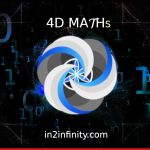Hi, welcome back. This is Colin Power from in2infinity talking about four dimensional mathematics today. We’re still on computers at the moment. So we’re going to be looking at a concept called to a processing the push forward and pull back function, which seems a little bit strange at first because, you know, we’re going to be working in jaw number sets, like we do in fourth dimensional mathematics. So what we’ll we’ll do is we’ll make a we’ll make a row of let’s make a row of zeros on into infinity. Let’s make that in there. Like let’s do it right down the page. Vertically. We’ve got one row of zeros there. And what we’ll do is we’re going to put another row of zeros parallel to that and that can go on into infinity as well in both directions. We could find the midpoint if you want and find that zero midpoint and then it goes into infinity in both directions. So what we want to do then from that midpoint infinity let’s say we changed that midpoint infinity to a one on one of the lines. And what we’ve done now is we’ve changed timespace mathematical algorithms are working. So what we can do is then we can say, Okay, what happens if we change the time space and switch time and space with number? And so we find that central zero and what happens is we can push that one across into the centre of the other infinite zero line. You can imagine that that’s his conceptual line, but computers can work out the midpoint, because it starts at zero. And so as we what we do is imagine we’ve got this infinite line infinite line, and what we’re gonna do is you’re gonna change one to one, right? And so we’ve got one at the centre of one one set of infinite zeros now, and 0% of another infinite set of zeros. And all we’re going to do is we’re going to try and push that one across. And we’re going to say, right, see where we see where it matches where there’s reciprocal competitors. Oh, yeah. See, there’s an opposite there. No, there’s a difference. There’s, it’s Oh, yeah, there’s a difference. Okay, flip that one. We can use a gate to do that. Just flip that we’re gonna push that one over there, boom, and turn yourself into a zero. So we’ve kind of like you know, posted the one across the the infinite space. And now that we’ve done that, obviously, the quality of the second one has now taken on the quality of the first and so we can now compare numbers and we could throw the one back and we can compare and make a comparison between numbers. And if you throw the Old One back and forth, we can make a comparison of certain numbers. Yeah. And so you can imagine we don’t just have to throw back and forth one number. We could throw back for any sort of number. Yeah, and what we call that is like mining, in a sense that zeros will turn to ones the ones will turn to zeros. So what you get then, is one way in one side, when it’s in one state, everything that’s a zero will be a one. And on the other side, a state the things that will be a one will be a one as well, but they’re in two different states or two different lines, aren’t they? And so you only know which which one is which, because of what we call the effort count whether that if account is odd, or whether it’s even if it’s odd, then it’s gone on to one side. And if it’s even then it’s gone back and it’s come back. And actually we don’t need to know. We can count the effort, but the only thing we need to know at the end is you know, what’s the is it odd or even and so now you can start to imagine we can use effort now to change change and calculate bits for changing one bit into another bit and that’s how it kind of works we can push forward. Just kind of like the one way speed of light. You know, we nobody knows the two way speed of light. We only know the one way speed of light and it can only go one direction and then it has to come back again. And we say oh, like that’s the speed of light. It’s gone there. And it’s come back and we’ve measured Okay, yeah. So give me the number, right, you see, I’m saying and so the same sort of thing goes with this. If you go one way it’s not number, and if you come back, it’s an even number. And so it’s gonna be it’s coming back and it’s an even number you know, it’s in the second channel. And if it’s, if it’s if it’s just going one way or if he’s going back and forward, like the effort count is three, you know that the we’re in the state, the state on the second on the first side, Zane, if everything comes together like that, then you can manipulate a bit line to equal things through effort. You know, you can make calculations because even in current binary system, those numbers represent numbers and you can say there’s times that equals that and you say, Okay, what do I need to do? I need to push an effort function. That will do did a and what we’ve done then is we’ve re engineered the way that computers can do calculations. And if you think about that, that’s at the very core of computing. And when you look at the way that the current computer processing works, it has all different types of gates did all this processes that it needs to go through hundreds of times just to form simple calculations. And yet here we are saying if we if we can calculate the effort function we can make a reciprocal function, which can be in a state, or even order even number. And in doing that, then we can sort of revolutionise the way that computers actually perform mathematics. And it comes quite deep from that. That’s just a very simple example. So there we are. That’s just a very simple but I’ll call that two way processing of fourth dimensional numbers.
And it’s a push to push forward and a pullback function of the bit between two spaces if you like. And we can do that through. We’re gonna separate out processes and all that sort of stuff, as we mentioned before in previous things and get proper number systems happening. Okay, so that’s all for this week. That’s about two way processing. My name is Franklin power. If you want to find out more about into infinity, you can go to our website where we talk all about fourth dimensional mathematics. We’ve got loads of stuff on atoms and all the other stuff as well. Very interesting stuff. So do come and check out into infinity and we’ll find out more about the fascinating world of fourth dimensional mathematics.


